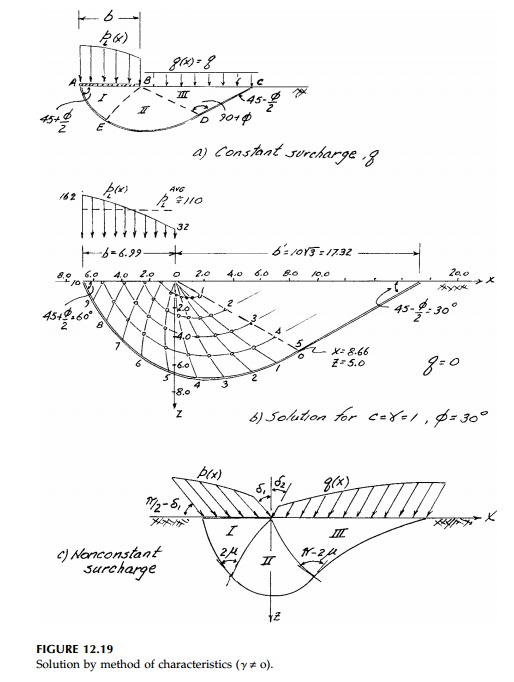Chapter: Civil : Principles of Solid Mechanics : Slip Line Analysis
Slip Line Analysis: The General Case
The General Case
Unfortunately K├ČtterŌĆÖs
equation cannot be integrated directly for a closedform solution in the general
case of a Coulomb material with weight or for nonconstant boundary loads. The
most common numerical procedure for integrating K├Čtter ŌĆÖs equation was
developed by V.V. Sokolovski* where the integration proceeds from one boundary
to the other in the direction of the characteristic slip lines using a finitedifference
approximation. This shooting technique called ŌĆ£the method of characteristicsŌĆØ
is necessary since, as already discussed, the governing equations are
hyperbolic and, if the load is specified completely on the entire boundary, a
solution will not normally exist.
The result then may be
an ŌĆ£exactŌĆØ solution for the slip field but only approximate the load
prescribed. Take for example the footing problem shown again in Figure 12.19.
We would like to solve for the uniform load intensity pL
that will cause collapse by forcing the material to shear under the punch and
bulge upward lifting the uniform surcharge q upward with the
passive wedge of region I. The solution starts from the boundary BC on which Žāz = q = constant, Žäxz = 0, and b' is selected to some
convenient scale. However, in this case region I is the passive Coulomb
solution with Žā3 = q so the stresses on BD are known and we can actually start from there.
Recurrence formulas for piecewise integration of K├ČtterŌĆÖs equation along the
characteristics in the fanshaped Region II and the Active Region III are
derived by Sokolovski. The accuracy depends on how dense we make the finiteelement
grid of characteristics (or slip lines).
The resulting slipline field and limit loading p(x) are shown in Figure 12.19b for a smooth, surface footing (q = 0) with c = ╬│ = 1 and ŽĢ = 30┬║. Neither the width of the footing, b, nor the distribution of the limit load pL can be specified in advance and we see that pL is far from uniform. Thus we have a

method that we can make
as accurate as we want to solve for the wrong load! One can use an equivalent
limit load intensity

to approximate a
uniform failure loading but that will still underestimate the capacity since
the moment around 0 is less. Reversing the direction of the shooting technique
does no good in that if p is specified constant, then q becomes a
function of x.
If q is not
constant, then as shown in Figure 12.19c, the slip surface s with ╬│ != 0 is neither straight, a log spiral, or circular in any zone. A variety of
solutions using the method of characteristics are presented in the literature
for the bearing capacity problem, slopes, and retaining walls for a variety of
surcharge distributions. Since these seldom correspond to realisticboundary
conditions they are primarily of academic interest.
Another approach to the
general problem is to incorporate the effect of weight using the same critical
slip surface derived by Prandtl for ╬│=0.
This cannot be correct, but a reasonable argument can be made that it is
conservative. This is the approach used by Terzaghi* in presenting his general
bearing capacity formula:

where N╬│ like the other two ŌĆ£Bearing Capacity FactorsŌĆØ Nc and Nq,
are functions of ŽĢ. The values for N╬│ given in Table 12.1 for the Prandtl Mechanism are obtained from the
approximation:

The power of the upperbound
approach to limit analysis, however, is supposed to be the simplicity of the
method. To return to this theme, let us conclude by introducing a simple
failure mechanism based, for the bearing capacity problem, on Coulomb wedges,
which is more versatile, easy for computation, and is intuitively satisfying.
Related Topics